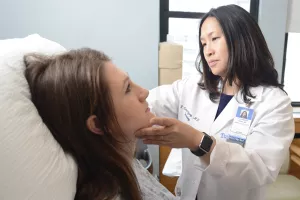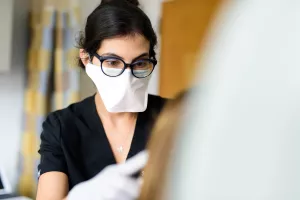It’s normal to shed hair in the shower, or when detangling knots, but when you're experiencing more hair loss than normal, it’s time to get in touch with our dermatologists. Also known as alopecia, hair loss can stem from hormonal changes, nutritional deficiencies, underlying medical conditions or chemotherapy treatment.
Getting ahead of hair loss
Hair loss disorders can affect your whole body, with the most common form of hair loss affecting the scalp. Alopecia can fall into the following 2 categories:
- Non-scarring alopecia: The most common form of hair loss is androgenetic alopecia, or male- and female-pattern hair loss. Because scarring isn’t blocking the hair follicles, you can still regrow your hair.
- Scarring alopecia: Inflammation causes irreversible damage to the hair follicle, ultimately leading to permanent hair loss.

Conditions
While androgenetic alopecia can be genetically passed down in families, some forms of hair loss are immune-mediated, meaning that your immune system mistakenly attacks hair follicles and causes inflammation.
Other forms of hair loss or hair shedding may be because of underlying medical problems or nutritional deficiencies. It's a good idea to start the conversation with your dermatologist or primary care doctor to understand better what's causing the condition. If you become concerned about hair loss, we can evaluate and treat you for conditions such as:
Other causes of hair loss can include:
- Chemotherapy- or cancer-induced hair loss
- Hair loss from medications or underlying medical conditions
- Nutritional deficiency
Testing
We carefully review your medical history and perform a detailed physical exam of your scalp and hair to determine the cause of your hair loss. Occasionally, we do additional blood work and a biopsy to confirm the diagnosis. A prompt diagnosis and treatment can improve the overall course of most hair loss disorders.
Treatments
One way to address hair loss is with platelet-rich plasma (PRP) treatment — a non-surgical, in-office procedure proven to restore hair growth for certain types of hair loss. Plus, it works well with other medical therapies.
PRP uses your body’s growth factors to nourish and stimulate hair growth. You can expect the following steps when undergoing PRP treatment:
- A care team member performs a blood draw
- We spin the blood through a process called centrifugation to isolate the PRP
- We inject the PRP into the affected area of your scalp
- The treatment typically requires 3 monthly sessions
- Return to the office every 3–6 months for maintenance therapy

From regular office visits to inpatient stays, find the healthcare you need and deserve close to home.

Meet the doctors and care team devoted to supporting you every step of the way along your path to better health.